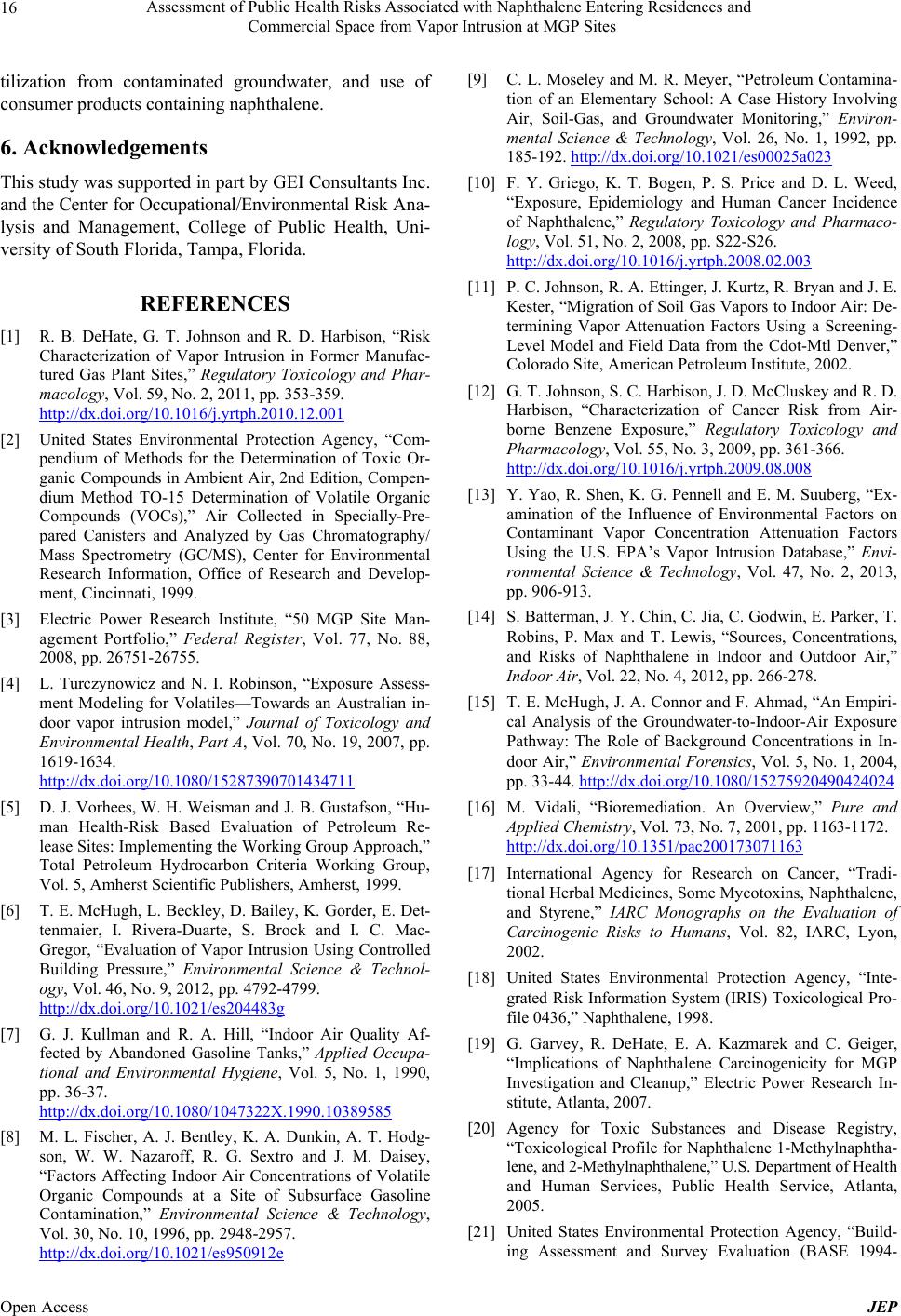
Assessment of Public Health Risks Associated with Naphthalene Entering Residences and
Commercial Space from Vapor Intrusion at MGP Sites
16
tilization from contaminated groundwater, and use of
consumer products containing naphthalene.
6. Acknowledgements
This study was supported in part by GEI Consultants Inc.
and the Center for Occupational/Environmental Risk Ana-
lysis and Management, College of Public Health, Uni-
versity of South Florida, Tampa, Florida.
REFERENCES
[1] R. B. DeHate, G. T. Johnson and R. D. Harbison, “Risk
Characterization of Vapor Intrusion in Former Manufac-
tured Gas Plant Sites,” Regulatory Toxicology and Phar-
macology, Vol. 59, No. 2, 2011, pp. 353-359.
http://dx.doi.org/10.1016/j.yrtph.2010.12.001
[2] United States Environmental Protection Agency, “Com-
pendium of Methods for the Determination of Toxic Or-
ganic Compounds in Ambient Air, 2nd Edition, Compen-
dium Method TO-15 Determination of Volatile Organic
Compounds (VOCs),” Air Collected in Specially-Pre-
pared Canisters and Analyzed by Gas Chromatography/
Mass Spectrometry (GC/MS), Center for Environmental
Research Information, Office of Research and Develop-
ment, Cincinnati, 1999.
[3] Electric Power Research Institute, “50 MGP Site Man-
agement Portfolio,” Federal Register, Vol. 77, No. 88,
2008, pp. 26751-26755.
[4] L. Turczynowicz and N. I. Robinson, “Exposure Assess-
ment Modeling for Volatiles—Towards an Australian in-
door vapor intrusion model,” Journal of Toxicology and
Environmental Health, Part A, Vol. 70, No. 19, 2007, pp.
1619-1634.
http://dx.doi.org/10.1080/15287390701434711
[5] D. J. Vorhees, W. H. Weisman and J. B. Gustafson, “Hu-
man Health-Risk Based Evaluation of Petroleum Re-
lease Sites: Implementing the Working Group Approach,”
Total Petroleum Hydrocarbon Criteria Working Group,
Vol. 5, Amherst Scientific Publishers, Amherst, 1999.
[6] T. E. McHugh, L. Beckley, D. Bailey, K. Gorder, E. Det-
tenmaier, I. Rivera-Duarte, S. Brock and I. C. Mac-
Gregor, “Evaluation of Vapor Intrusion Using Controlled
Building Pressure,” Environmental Science & Technol-
ogy, Vol. 46, No. 9, 2012, pp. 4792-4799.
http://dx.doi.org/10.1021/es204483g
[7] G. J. Kullman and R. A. Hill, “Indoor Air Quality Af-
fected by Abandoned Gasoline Tanks,” Applied Occupa-
tional and Environmental Hygiene, Vol. 5, No. 1, 1990,
pp. 36-37.
http://dx.doi.org/10.1080/1047322X.1990.10389585
[8] M. L. Fischer, A. J. Bentley, K. A. Dunkin, A. T. Hodg-
son, W. W. Nazaroff, R. G. Sextro and J. M. Daisey,
“Factors Affecting Indoor Air Concentrations of Volatile
Organic Compounds at a Site of Subsurface Gasoline
Contamination,” Environmental Science & Technology,
Vol. 30, No. 10, 1996, pp. 2948-2957.
http://dx.doi.org/10.1021/es950912e
[9] C. L. Moseley and M. R. Meyer, “Petroleum Contamina-
tion of an Elementary School: A Case History Involving
Air, Soil-Gas, and Groundwater Monitoring,” Environ-
mental Science & Technology, Vol. 26, No. 1, 1992, pp.
185-192. http://dx.doi.org/10.1021/es00025a023
[10] F. Y. Griego, K. T. Bogen, P. S. Price and D. L. Weed,
“Exposure, Epidemiology and Human Cancer Incidence
of Naphthalene,” Regulatory Toxicology and Pharmaco-
logy, Vol. 51, No. 2, 2008, pp. S22-S26.
http://dx.doi.org/10.1016/j.yrtph.2008.02.003
[11] P. C. Johnson, R. A. Ettinger, J. Kurtz, R. Bryan and J. E.
Kester, “Migration of Soil Gas Vapors to Indoor Air: De-
termining Vapor Attenuation Factors Using a Screening-
Level Model and Field Data from the Cdot-Mtl Denver,”
Colorado Site, American Petroleum Institute, 2002.
[12] G. T. Johnson, S. C. Harbison, J. D. McCluskey and R. D.
Harbison, “Characterization of Cancer Risk from Air-
borne Benzene Exposure,” Regulatory Toxicology and
Pharmacology, Vol. 55, No. 3, 2009, pp. 361-366.
http://dx.doi.org/10.1016/j.yrtph.2009.08.008
[13] Y. Yao, R. Shen, K. G. Pennell and E. M. Suuberg, “Ex-
amination of the Influence of Environmental Factors on
Contaminant Vapor Concentration Attenuation Factors
Using the U.S. EPA’s Vapor Intrusion Database,” Envi-
ronmental Science & Technology, Vol. 47, No. 2, 2013,
pp. 906-913.
[14] S. Batterman, J. Y. Chin, C. Jia, C. Godwin, E. Parker, T.
Robins, P. Max and T. Lewis, “Sources, Concentrations,
and Risks of Naphthalene in Indoor and Outdoor Air,”
Indoor Air, Vol. 22, No. 4, 2012, pp. 266-278.
[15] T. E. McHugh, J. A. Connor and F. Ahmad, “An Empiri-
cal Analysis of the Groundwater-to-Indoor-Air Exposure
Pathway: The Role of Background Concentrations in In-
door Air,” Environmental Forensics, Vol. 5, No. 1, 2004,
pp. 33-44. http://dx.doi.org/10.1080/15275920490424024
[16] M. Vidali, “Bioremediation. An Overview,” Pure and
Applied Chemistry, Vol. 73, No. 7, 2001, pp. 1163-1172.
http://dx.doi.org/10.1351/pac200173071163
[17] International Agency for Research on Cancer, “Tradi-
tional Herbal Medicines, Some Mycotoxins, Naphthalene,
and Styrene,” IARC Monographs on the Evaluation of
Carcinogenic Risks to Humans, Vol. 82, IARC, Lyon,
2002.
[18] United States Environmental Protection Agency, “Inte-
grated Risk Information System (IRIS) Toxicological Pro-
file 0436,” Naphthalene, 1998.
[19] G. Garvey, R. DeHate, E. A. Kazmarek and C. Geiger,
“Implications of Naphthalene Carcinogenicity for MGP
Investigation and Cleanup,” Electric Power Research In-
stitute, Atlanta, 2007.
[20] Agency for Toxic Substances and Disease Registry,
“Toxicological Profile for Naphthalene 1-Methylnaphtha-
lene, and 2-Methylnaphthalene,” U.S. Department of Health
and Human Services, Public Health Service, Atlanta,
2005.
[21] United States Environmental Protection Agency, “Build-
ing Assessment and Survey Evaluation (BASE 1994-
Open Access JEP